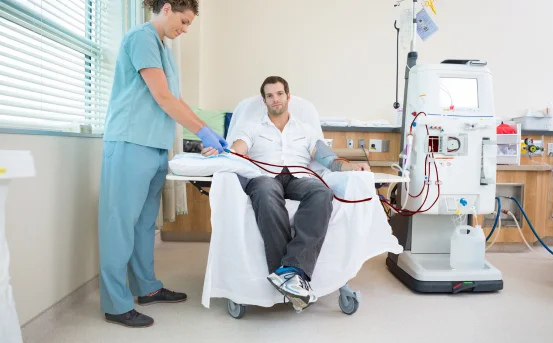Bladder tumor removal is a common procedure to treat both non cancerous and cancerous growths in the bladder lining. While this surgery often done via transurethral resection of bladder tumor (TURBT) is minimally invasive, patients can experience several post operative symptoms as their body heals. Understanding these symptoms after bladder tumor removal is essential for early detection of complications and ensuring a smoother recovery.
Although bladder tumor removal is typically safe and straightforward, patients may experience a variety of symptoms during the recovery period. These post operative symptoms can range from mild urinary discomfort to more concerning issues like bleeding or bladder spasms. Being aware of what to expect after bladder tumor removal can help patients manage their recovery better, identify potential complications early, and reduce anxiety about the healing process.
What Is Bladder Tumor Removal?
Bladder tumor removal is a surgical procedure where abnormal growths from the bladder are extracted. The most common approach is TURBT, where a surgeon inserts a scope through the urethra to scrape or burn away the tumor without external incisions.
This procedure is typically used for
-
Diagnosing the type and grade of the tumor
-
Treating early stage bladder cancer
-
Removing benign growths
Patients undergoing this surgery may be hospitalized for a short time or discharged the same day, depending on the complexity and extent of tumor removal.
Common Symptoms of Bladder Tumor Removal
Experiencing some degree of discomfort or urinary changes after bladder tumor surgery is entirely normal. The bladder and surrounding tissues need time to heal, and mild symptoms are usually temporary.
-
Blood in Urine (Hematuria) :- One of the most common symptoms after bladder tumor removal is blood in the urine. This can range from a light pink tinge to visible red streaks. Hematuria typically resolves within a week, but if the bleeding increases or persists, it’s important to consult your doctor.
Small blood clots may also pass in the urine during the healing process. Drinking plenty of water can help flush out the bladder and reduce irritation.
- Burning Sensation During Urination :- Many patients report a burning or stinging sensation while urinating for several days post surgery. This happens due to irritation of the bladder lining or urethra and is not uncommon. While discomfort is expected initially, persistent burning beyond a week should be evaluated to rule out infection.
- Increased Urinary Frequency and Urgency :- After the procedure, the bladder may become overly sensitive, leading to more frequent urges to urinate even if the bladder isn’t full. Some patients feel an urgent need to urinate but pass only small amounts. These symptoms usually subside over time but can be bothersome during the initial recovery phase.
- Bladder Spasms :- Bladder spasms are involuntary contractions of the bladder muscles that may cause cramping or sudden urgency to urinate. They can feel like abdominal cramps and are common following catheter use or surgical manipulation inside the bladder. Medication may be prescribed if spasms are severe or painful.
Symptoms That May Indicate Complications
While most post-surgical symptoms are manageable, certain signs may point to complications such as infection, bleeding, or recurrence of the tumor. It’s essential to monitor your recovery closely.
- Persistent or Heavy Bleeding :- If urine remains bright red or if large clots are passed even after a week, it could indicate a bleeding complication. This may require medical evaluation, especially if it interferes with urination.
- Fever and Chills :- A fever over 100.4°F (38°C), chills, or a feeling of being unwell may signal a urinary tract infection (UTI) or even a more serious condition like a bladder infection. Immediate medical attention is necessary in such cases to prevent worsening of the condition.
- Pain That Doesn’t Improve :- Mild lower abdominal or pelvic pain is expected, but if pain worsens or becomes severe, it could be due to an infection, bladder perforation, or urinary retention. Any increasing discomfort should not be ignored.
- Inability to Urinate :- A complete inability to urinate after the catheter is removed is a red flag. It may indicate swelling, a blockage, or issues with bladder function post-surgery. Urinary retention can be painful and requires prompt medical care.
Long Term Symptoms and Follow Up
Bladder tumor removal doesn’t end with surgery. Follow up care is crucial to monitor for tumor recurrence, especially in cases of non muscle invasive bladder cancer (NMIBC), which has a tendency to return.
- Recurrence of Symptoms :- If you begin to notice symptoms like frequent urination, burning, or blood in the urine months after the surgery, it could indicate tumor recurrence. Periodic cystoscopies and urine tests are recommended by urologists as part of long-term surveillance.
-
Lifestyle Adjustments :- Patients may need to limit physical activity during the first few weeks after surgery. Heavy lifting, straining, or vigorous exercise should be avoided to prevent bleeding or stress on the healing bladder.
Some individuals may experience changes in urinary habits long-term, especially if multiple resections are needed or if intravesical therapies like BCG (Bacillus Calmette-Guerin) are administered afterward.
Recovery Timeline After Bladder Tumor Surgery
Here’s a general idea of what to expect in terms of recovery
-
First 3 days :- Mild blood in urine, burning sensation, light cramping
-
1st week :- Most symptoms begin to improve; blood in urine reduces
-
2nd to 3rd week :- Normal urinary habits return; energy levels improve
-
After 1 month :- Full recovery in most cases, unless additional treatment is required
Keep in mind that each individual heals at a different pace, and those with pre-existing health conditions or repeated tumor resections may take longer to recover.
When to Call Your Doctor?
Seek immediate medical attention if you experience
-
Fever, chills, or signs of infection
-
Bright red blood or heavy bleeding beyond a week
-
Severe pelvic or abdominal pain
-
Difficulty or inability to urinate
-
Persistent burning sensation after 7 days
Conclusion
Symptoms after bladder tumor removal vary depending on the size and type of tumor, the extent of resection, and individual health factors. While some discomfort and urinary changes are normal, staying aware of your symptoms helps ensure proper healing and early intervention if complications arise.























